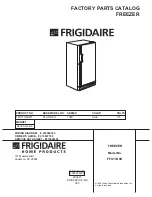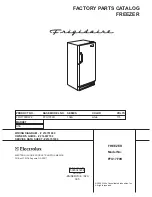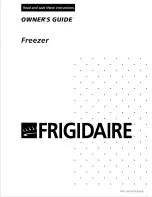
Instructions for Use
13
Approximate Storage Time of Frozen Foods
Food
Storage time (in months)
1
2
3
4
5
6
7
8
9
10
11
12
Vegetable
+
+
+
Fruit
+
+
+
Braed, Pastries
+
Milk
+
Redy-made meals
+
Meat: Beef
+
+
+
Veal
+
+
+
Pork
+
+
+
Poultry
+
+
+
Game
+
+
+
Minced meat
+
Smoked sausages
+
Fish: lean
+
fat
+
Offal
+
Defrosting of Frozen Food
Partially thawed or defrosted foods should be used as soon as
possible. Cold air preserves the food but it does not destroy
microorganisms which rapidly activate themselves after
defrosting and make foods perishable.
Partial defrosting reduces the nutritional value of foods,
especially of fruits, vegetables and ready-made meals.
Maintenance and Cleaning
Freezer Defrosting
Frost and ice layer, depositing on the inner walls of the freezer
should be defrosted when 3-5 mm thick.
•
24 hours prior defrosting press the continued operation
mode button
(2)
(yellow lamp is on) to provide extra low
temperature of food inside the freezer. After this period take
the food out and protect them from melting.
•
Disconnect the appliance from the mains supply.
•
Avoid using defrosting sprays, as they may cause damage
to the plastic parts and may be hazardous to health.
•
Water collected at the bottom basket of the appliance should
be mopped with a sponge or highly absorbing cloth.
Cleaning the Appliance
Before cleaning the appliance disconnect the cable from
the mains supply.
Do not use abrasive cleaning agents.
•
Clean the
exterior
of the appliances with water and liquid
detergent.
Varnished surfaces are cleaned with soft cloth and an
alcohol based cleaning agent (for example glass cleaners).
You may also use alcohol (ethanol or isoprophylic alcohol).
The application of abrasive and specially aggressive
cleaners, such as the stainless steel cleaners, is not
appropriate for the cleaning of plastic and coated parts.
•
Wash the
interior
with lukewarm water and some vinegar.
•
The air openings in the bottom rail
should be cleaned or
vacuumed periodically.
•
Sound alarm signals the excessive dusting of the
condenser
. The alarm may be switched of by the alarm off
button
(3)
.
Cleaning of the condenser
Dust from the condenser should be vacuumed in the
following manner:
−
push the finger through the opening in the bottom rail
and release the fastener;
−
pull the rail towards you and remove it;
−
remove the bottom board of the kitchen cabinet;
−
pull the condenser dish out;
−
use the vacuum cleaner to clean the dust from the
condenser;
−
replace the condenser dish and the bottom rail in the
opposite order.
After you have cleaned the appliance, reconnect it to the
mains supply and put the food packages back to their place.
Periodical cleaning of the condenser
In order to optimize the operation of the appliance and
save energy, it is recommended to clean periodically
the dust from the condenser at the back of the
appliance.
Disconnect the appliance from the mains prior the
commencement of cleaning!
•
Empty the contents of the appliance.
•
Remove the supporting panel from the bottom of the kitchen
cabinet.
•
Remove the screws fixing the appliance to the kitchen
worktop.
•
Pull the appliance out and expose the condenser at the back
of the appliance.
•
Unscrew the screws from the condenser bonnet and remove
the bonnet.
•
Clean the dust and dirt from the condenser.
After cleaning return the appliance to its place, plug in the
mains power cord and fill with food.
Switch Off the Appliance When Not in Use
If you do not intend to use the appliance for a longer period of
time, disconnect the power supply, empty the appliance,
defrost it and clean it. Leave the door slightly open.




































